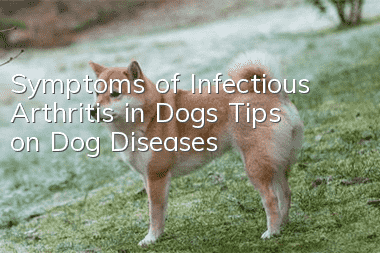Symptoms of Infectious Arthritis in Dogs Tips on Dog Diseases

Symptoms of infectious arthritis in dogs
X-ray examination
1. Early X-rays show thickening of the joint synovium and joint capsule and widening of the joint cavity. As the condition worsens, joint damage occurs, the tissue around the joint is sparse, the joint surface is irregular, and some show fibrous or bony ankylosis.2. Joint puncture revealed degeneration of synovial fluid and an increase in leukocytes, mostly neutrophils.
3. Puncture bacterial culture can be done to determine the type of bacterial infection. However, it is difficult to detect the results of bacterial culture in patients who have been treated with antibiotics.
Clinical symptoms
1. The affected joints are swollen, hot and painful, a large amount of serous, fibrous or purulent exudate accumulates in the joint cavity, the joint capsule swells, and there is a fluctuating sensation when pressed.2. Claudication of the affected limb is often accompanied by an increase in body temperature; over time, the articular cartilage is destroyed, the subchondral bone is eroded, bone hyperplasia around the joint bone, and the synovial membrane is thickened; in the later stage, it may develop into fibrous or osseous Sexual joint healing, ankylosis or dead joints.
Causes of infectious arthritis in dogs
1. Exogenous joint infection is common after joint trauma, direct infection by pathogenic bacteria or the spread of purulent inflammation in the same tissue around the joint.2. Blood-borne infection, which refers to the infection of joints by pathogenic bacteria from primary lesions such as pneumonia, umbilical corditis, and urinary tract infection.
3. Iatrogenic infections are common in surgical contamination such as arthrotomy and joint puncture.
Prevention and treatment measures for dog infectious arthritis
1. Based on bacterial culture and drug sensitivity testing, antibiotics that are sensitive to bacteria can be used for several weeks until the infection subsides. It can be administered intravenously within the first 48 hours to quickly control the infection.2. Move the joints appropriately to prevent joint adhesions in sick dogs, but it is not advisable to bear weight within 3 to 4 months to avoid wear and tear of articular cartilage.
3. When too much pus accumulates in the joint, puncture or incision can be made, and a drainage tube can be placed to facilitate the discharge of purulent secretions and flushing. Rinse with sterile isotonic solution once a day.
4. In patients with a long course of disease, the articular cartilage and articular bone are generally more severely damaged. After the inflammation is controlled, it is easy to turn into degenerative joint disease, and the function is difficult to recover.
Random articles
- What do dogs eat to protect their stomach? It is important to protect their stomach and treat gastrointestinal diseases in dogs.
- How to tell if your dog is fat? Is your dog overweight?
- Will your dog catch a cold if you blow the air conditioner? What should you do if your dog catches a cold if you blow the air conditioner?
- What should you pay attention to when your dog drinks water? Don’t be careless when it comes to your dog’s drinking water.
- The dog's mouth bites and shakes. Why does the dog's mouth occasionally shake and bite?
- How to cut a dog's hair? Do you know how to cut a dog's hair correctly?
- Can dogs eat raw eggs? Why can’t dogs eat egg whites?
- Common Dog Problems in Summer How to Deal with Different Dog Problems
- How to keep dogs away from skin diseases. If you do this, will you see if your dog will still be infected with skin diseases?
- What causes anorexia in dogs? Dogs will become anorexic due to lack of exercise. Hounds run at least 5KM every day.



